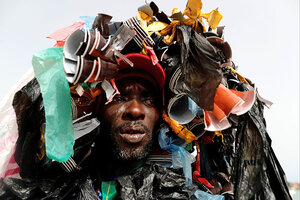Beachcombers worldwide haul 20 million pounds of trash in one day

Modou Fall, head of Senegal Propre, or Clean Senegal Association, wore plastic cups and bags to raise awareness of the damage on the environment caused by waste. Mr. Fall took part in the International Coastal Cleanup in Dakar, Senegal, Sept. 15.
Zohra Bensemra/Reuters
Picking up trash on a beach early on a foggy weekend morning is an unlikely activity for college students. But for a group from the University of Massachusetts Boston dressed in “Green Planet” shirts, enthusiasm surges as they slip on latex gloves. They are members of UMass Boston’s Green Planet Living Learning Community, which combines classes on sustainability, eco-conscious housing, and environmental outreach.
The volunteers dump all they’ve found here near Boston Harbor onto a blue tarp: water bottle caps, shards of tiny plastic, a few syringes.
For one student, the haul seems pitifully small – both a sign of how far Boston has come since The Standells sang their “Dirty Water” ode to the city’s Charles River in 1965, and how much more needs to be accomplished worldwide.
Why We Wrote This
With many hands on the task, the International Coastal Cleanup shows how communities working together can highlight a problem and help solve it. Legislation is starting to have an impact, too.
Dlynzee Damas, a sophomore majoring in environmental science, is originally from Haiti, where plastic waste is typically dumped directly into the ocean. “[M]ost of what we’ve picked up [today] is tiny – there’s not a lot of trash compared to everywhere else,” she says.
Though the pickings seemed slim to Ms. Damas, UMass Boston students were a small part of the hundreds of thousands of people in 106 countries beachcombing with a purpose that day. Together, they picked up about 20.5 million pounds of trash as part of the International Coastal Cleanup on Sept. 15, which was started by the Ocean Conservancy in 1986 to illustrate the role communities play in solving the problem of marine debris. In the past 30 years both the number of volunteers and the amount of trash collected has grown exponentially – from an estimated 2,800 volunteers that first year, to some 400,000 volunteers in 2008, and nearly 800,000 last year.
“These things are taking our attention back to the water and identifying how we’re connected to it. The sea is no longer able to hide or conceal the lifestyles of consuming nations,” says Patricia Widener, associate professor of sociology at Florida Atlantic University in Boca Raton, Fla.
Nearly 8 million tons of plastic entered the oceans in 2010, according to a 2015 study published in the journal Science. That number is projected to double by 2020. But there has also been a groundswell of grassroots movements and local legislation to ban single-use plastic and clean up the world’s litter.
“Over the last five to 10 years we’ve seen a rapid increase in public awareness about the issue, and more importantly, we’ve seen concern by citizens increasing,” says Nicholas Mallos, director of the Trash Free Seas program at the nonprofit Ocean Conservancy. When something as innocuous as a plastic straw is thrown onto a beach, out the window, or into a sewer, it can have global repercussions, experts say.
“Plastic could end up affecting ecosystems or people very far away. That’s hard for anybody to understand at an individual level. And while people are consuming products made of single-use plastic, they’re not thinking about that,” says Anne-Marie Hanson, associate professor of environmental studies at the University of Illinois, Springfield.
“We’ve gotten used to a lifestyle where we throw away things after one use … as long as we use single-use containers, there will always be more than we can actually clean up,” she adds.
More than 60 countries and two US states have bans on single-use plastic bags. Bioplastics, which biodegrade over a few months instead of centuries, are catching on worldwide. And a Dutch entrepreneur is launching a giant trash-collecting boom into the Great Pacific Garbage Patch – the largest concentration of plastic in the ocean – although many marine biologists and oceanographers are skeptical.
“When we talk about policies being introduced, these towns and cities with comprehensive single use [plastic bans] are leading the example,” says Linda Booker, director of the 2017 documentary “Straws.” She points to teenagers as being at the center of these policy changes. “The kids have been the most incredible activists, and they’ve had the most effective campaigns. They’re talking to restaurant owners, making campaigns in their schools, and taking pledges. They care very deeply, and especially don’t want to see animals hurt.”
While coastal cleanups and a patchwork of single-use bans have created momentum, they are only a start to a widening problem in need of global solutions.
“If you’re doing a beach cleanup and not voting, you may be cleaning those beaches for a long time,” says Professor Widener. “It’s a different thing for an individual to stop using plastic versus to pressure national leaders to change policy with regard to plastic use.”
Back at the beach clean-up in Boston, sophomore Collin Oliver reflected on plastic’s future.
“It’s a growing awareness, but it’s only in its middle stages,” he says. “We live here, so if we go to a beach right where we live, we can make a difference – and it hits a lot closer to home.”

